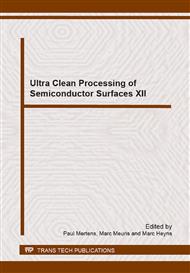p.52
p.56
p.59
p.63
p.68
p.73
p.78
p.81
p.85
Surface Cleaning of Graphene by CO2 Cluster
Abstract:
Graphene has attracted researchers due to its unique physical properties [1]. However, residues on surface can act as contaminants which further have adverse effects on its performance. As synthetic graphene has inherent surface roughness which can also affect the weak adhesion of layers and leakage points. In order to improve the mechanical and electrical properties, the graphene surface should be uncontaminated. In general practice wet cleaning methods, containing hazardous chemical and solvents are used to remove the residues from graphene surface [2, 3]. To avoid chemicals, mechanical cleaning of graphene using contact mode atomic force microscopy (AFM) has been tried. However, the contact mode AFM cleaning is a limited in cleaning area and the cleaning procedure takes a long time. Recently, CO2 cluster cleaning shows benefits that overcomes these problems. Herein we report the use of CO2 cluster to clean the graphene surface without affecting its inherent properties for the first time. The CO2 cluster treated graphene samples were evaluated by AFM for its roughness change and residual contamination.
Info:
Periodical:
Pages:
68-70
Citation:
Online since:
September 2014
Authors:
Keywords:
Price:
Сopyright:
© 2015 Trans Tech Publications Ltd. All Rights Reserved
Share:
Citation:



